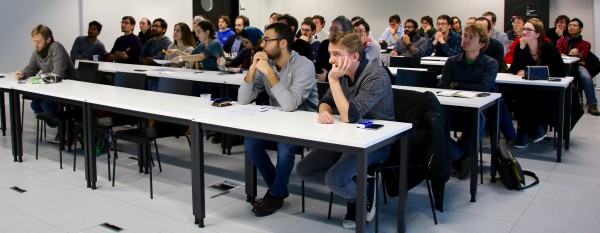MARVEL Junior Seminar — May 2018
The MARVEL Junior Seminars aim to intensify interactions between the MARVEL Junior scientists belonging to different research groups located at EPFL. The EPFL community interested in MARVEL research topics is very welcome to attend. We believe that these events will be central for establishing a vibrant community.
Each seminar consists of two presentations of 25 minutes each, allowing to present on a scientific question in depth, each presentation being followed by 10 minutes for discussion. The discussion is facilitated and timed by the chairperson of the day whose mission is to ensure active lively interactions between the audience and the speakers.
Pizza is served as of 11:45 in the MED hall (floor 0), and after the seminar at 13:30 you are cordially invited for coffee and dessert to continue discussion with the speakers.

MARVEL Junior Seminar Organizing Committee — Francesco Ambrosio, Davide Campi, Edgar Engel, Gloria Capano, Michele Pizzochero, Quang Van Nguyen, Kun-Han Lin, Francesco Maresca and Nathalie Jongen
Check the list of the next MARVEL Junior Seminars here.
Abstract — Koopmans-compliant functionals: A reliable and efficient tool for the prediction of spectroscopic quantities- Nicola Colonna
Commonly used approximate density functionals produce total energies that do not exhibit the expected piecewise-linear behavior as a function of the particle number, leading to a discrepancy between total and partial electron removal/addition energies and poor predictive capabilities of ionization potentials. Koopmans-compliant functionals enforce a generalized criterion of piecewise linearity in the energy of any approximate density functional with respect to the partial removal/addition of an electron - i.e., with respect to charged excitations - from/to any orbital of the system. When used to purify approximate density functionals, Koopmans’ corrections lead to orbital-density dependent functionals and potentials that are able to deliver accurate spectroscopic properties. As an example, ionization potentials of a large set of molecules (the GW100 test set), photoemission spectra of organic donors and acceptors and band gaps of 35 semiconductors and insulators are presented, showing very good agreement with experiment or higher-order theories. Being this a functional framework, the straightforward advantages are that forces and other derivatives are also readily accessible, that the computational costs are much reduced, and the numerical parameters are those typical of DFT calculations.
Abstract — Structure and mobility of the austenite/martensite interface in steels - Francesco Maresca
The austenite/martensite (fcc/bcc) interface dominates a broad class of high-strength steels. Decades of research left unclear both its defect structure and mechanism of motion. We have used atomistic simulations to create a glissile fcc-bcc iron interface with a defect structure completely consistent with experiments, namely [-101]fcc screws gliding on (111)fcc, as envisioned by previous theories, and [1-11]bcc kinks gliding on (-101)bcc, which was never envisioned before. Based on this newly discovered interface structure, we have proposed a revised, parameter-free double-shear theory of lath martensite. Theory predictions are in very good agreement with experiments in Fe-Ni-Mn and Fe-C, and show that the dominant factor controlling the transformation strain, and hence toughening, is the lattice parameter ratio. This new understanding of this interface can provide guidelines for the design of new high strength steels.
Authors: Francesco Maresca, William Curtin
Low-volume newsletters, targeted to the scientific and industrial communities.
Subscribe to our newsletter